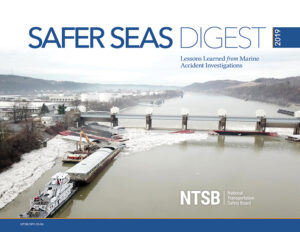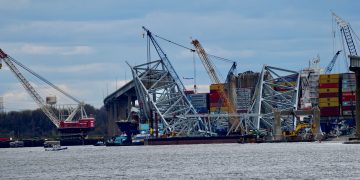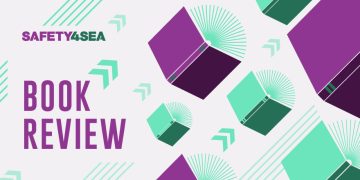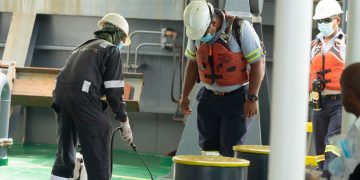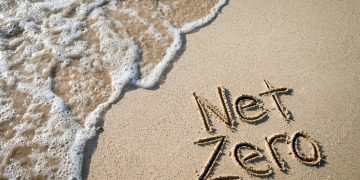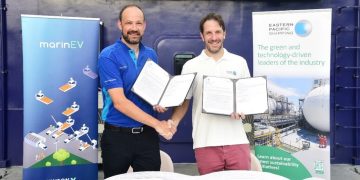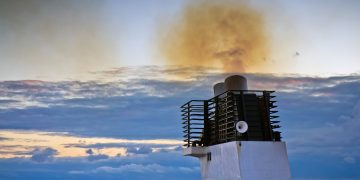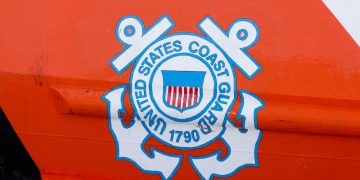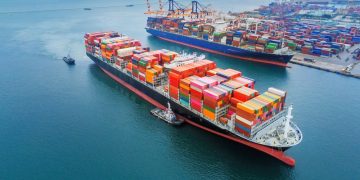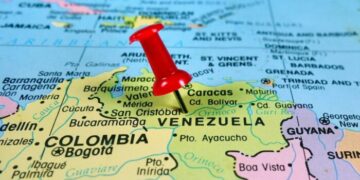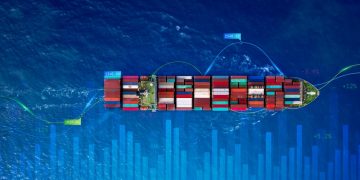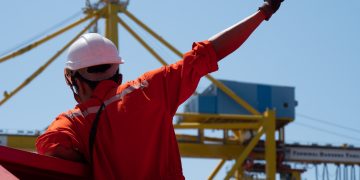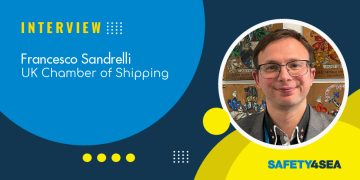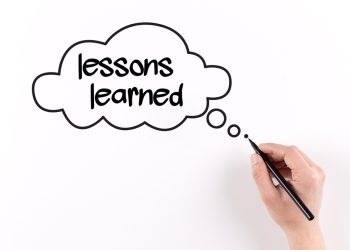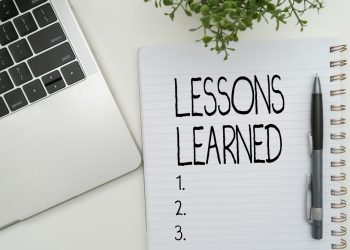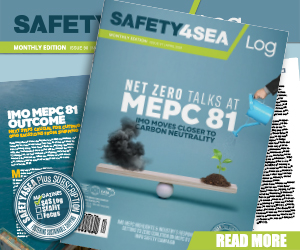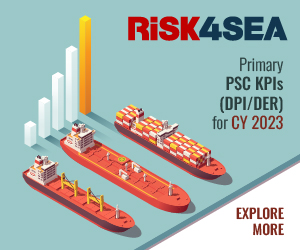The NTSB issued its Safer Seas Digest, sharing older and new lessons learned as identified thorough its incident investigations in 2019. This aims to help mariners to view their operations with a critical eye and act accordingly in their day-to-day routines.
It is…critical for mariners and others in the marine industry to be able to view their own operation through the eyes of an investigator. What lesson would investigators say should have already been learned, if your vessel were in an accident?
-Organizational Oversight
In over one-third of all accidents reported on in 2019, insufficient organizational oversight was the primary or a contributing cause.
Insufficient organizational oversight was a factor in the Stretch Duck 7, Buster Bouchard-B. No. 255, John S McCain–Alnic MC, Imperial, Dredge200–R.E. Pierson 2, Miss Roslyn, Jeanette, Ram XVIII, PTC 598, Atlantic Giant II, Jonathon King Boyd–Bayou Chevron, Natalie Jean, Emsworth Locks and Dams, Yochow–OSG Independence/OSG 243, and Ms Nancy C accidents.
-Fatigue
Fatigue was once again a leading primary or contributory cause in accidents in 2019. Companies should include fatigue management procedures in their safety management systems and ensure compliance with applicable work/rest requirements.
Meanwhile, a watch alarm, if used as intended, is an effective tool that can help ensure that a crewmember remains awake and vigilant while on duty. However, a watch alarm is not a substitute for the management and mitigation of fatigue. Owners/ operators of vessels equipped with a watch alarm should establish procedures for its operation and use, especially when only one crewmember is responsible for navigation and lookout.
Fatigue was a factor in the Aaron & Melissa II, John S McCain– Alnic MC, Shandong Fu En, Imperial, and Yochow/OSG IndependenceOSG 243 accidents
-Master/Pilot Exchange
The master/pilot exchange is a critical component of bridge resource management and is more than a simple exchange of vessel particulars. The master/pilot exchange is an opportunity to ensure the pilot and bridge team can clearly communicate and have a shared mental model of the task ahead.
A formal master/pilot exchange should be conducted whenever a pilot comes aboard a vessel, regardless of the level of familiarity with the pilot, with the master, and the vessel.
A failure to conduct a comprehensive master/pilot exchange was a factor in the Nippon Maru and Carnival Horizon accidents.
See also: Communication a main factor of accidents at sea: Three real-life examples
-Proper Navigation
The safety of a vessel while underway depends on awareness of the vessel’s position and adherence to a voyage plan. Good seamanship requires correlating information from all means of navigation, including satellite, radar, and visual aids to navigation. Crewmembers navigating the vessel should be familiar with electronic charting systems, radars, GPS and other systems.
A failure to use all means of navigation to determine a vessel’s position was a factor in the Andrew Cargill MacMillan and Capt. M&M accidents.
-Dynamic Risk Assessment
Owners and operators should conduct a risk assessment prior to vessel operations to determine potential hazards and mitigate dangers. Once a voyage or operation has commenced, unplanned changes to work plans can move operations incrementally toward states of higher risk.
Dynamic risk assessment requires that work stop when new hazards are identified, the situation is evaluated, and action is taken to control the added risks. Vessel operators should ensure crews at all levels of the organization have the authority and/ or obligation to stop work when such hazards are identified.
A failure to identify risk before commencing operations was a factor in the Weeks 207–Seeley– Sea Jay accident. A lack of effective dynamic risk assessment resulted in a failure to recognize emergent dangers in the Stretch Duck 7, Atlantic Giant II, and Aaron & Melissa II accidents.
-Proper Lookout
Non-navigational routines should never interfere with the primary task of a watchstander or a bridge team member to maintain a proper lookout. Should performance of another task or duty be necessary, an extra lookout should be posted.
The failure to maintain a proper lookout was a factor in the Got‘M On–Lady Toni and Polaris– Tofteviken accidents.
-Early Communication Prior to and During Emergency Situations
Early communication can be an effective measure in averting accidents or reducing injuries and loss of life in the event of an accident. In close quarters situations, the use of VHF radio can help to dispel assumptions and provide operators with the information needed to better assess each vessel’s intentions. In emergencies, rapid notification allows search and rescue authorities to respond quickly.
A lack of early VHF radio communications during a close quarters situation was a factor in the Polaris–Tofteviken and John S McCain–Alnic MC accidents. A failure to notify authorities in a timely manner delayed emergency response efforts in the Chipolbrok Moon accident, whereas an early distress call likely saved lives in the Ram XVIII accident.
-Heavy Weather Conditions
Owners and operators should develop voyage plans that assess prevailing weather conditions and anticipate changes along the intended route. Regardless of requirements, planning and preparation before a voyage is critically important, including the identification of safe harbors along the route and adherence to operational limits.
If unexpected weather conditions arise during a voyage, operators should consider options that minimize the risk to the crew and the vessel, including returning to port.
Inneffective planning for forecasted heavy weather conditions was a factor in the Stretch Duck 7, Dredge200–R.E. Pierson 2–Big Jake, and Aaron & Melissa II accidents. Unusual wave height during heavy weather was a factor in the Progress accident.
-Seafloor Hazards in Undersea Operations
During undersea operations such as dredging of liftboat operations, seafloor conditions, including the presences of pipelines, cables, or can holes; bottom changes due to storm passages; proximity to major rivers; and soil composition can pose significant hazards to safe operations.
Owners, operators, and charterers should use all available information for safe operations, including, but not limited to, available charts, maps, and sounding data; soil analysis, penetration history for the site, and/or core samples, before commencing operations.
Insufficiently accounting for known seafloor hazards was a factor in the Ram XVIII and Jonathon King Boyd–Bayou Chevron accidents.
-Effective Hull and Structural Component Inspection & Maintenance
To protect vessels, their crews, and the environment, it is good practice for owners to conduct regular oversight and maintenance of hulls and structural components of a vessel, including between drydock periods.
Regardless of inspection requirements, owners are obligated to ensure vessels are properly maintained, equipped, and operated in a safe condition. Issues with watertight integrity and wastage need to be addressed by permanent means.
Ineffective hull and structural component inspection and maintenance were factors in the Aaron & Melissa II, Miss Roslyn, Buster Bouchard/B. No. 255, and Ms Nancy C accidents.
-Watertight Integrity and Subdivision
Maintaining watertight integrity of the hull of a vessel, to include securing hatches and doors and maintaining the material condition of hull plating, is a fundamental principal of safe operations on water. Within the hull, watertight bulkheads are designed to prevent progressive flooding when portions of the hull are compromised in a collision or other contact. Cutting holes in these bulkheads for ease of access to adjacent spaces defeats the designed intent of the bulkheads. Vessel owners, operators, and crews should ensure the integrity of their vessels’ watertight subdivision is maintained.
A lack of watertight integrity and compromised or inadequate subdivision were factors in the Stretch Duck 7, Capt. M&M, and PTC 598 accidents.
-Fire Protection During Hot Work
It is critical to evaluate work areas for fire hazards to ensure that adequate protection is in place. Crewmembers involved in hot work should be trained to identify possible hazards and take action to remove or mitigate these potential risks to the vessel and crew.
The fire watch should not perform any other duties while acting as fire watch and should remain on-site until the area is deemed to be safe, unless relieved by another crewmember. In addition, notifying shoreside authorities both before conducting hot work and in the event of a fire allows port authorities to properly prepare and respond more rapidly.
Inadequate fire protection during hot work was a factor in the Jeanette accident. Inadequate fire protection during hot work and delayed notification to port authorities when a fire broke out were factors in the Chipolbrok Moon accident.
-Securing Ventilation and Openings During a Fire
When using installed firefighting systems or throwable grenade-type aerosol fire extinguishers, crewmembers should secure ventilation (fans and vent registers/louvers) and close all openings, such as engine room doors and windows, to ensure the maximum effectiveness of the extinguishing agent.
When using extinguishing systems or designing any vessel space for the prevention of fires, vessel owners and operators should identify openings, provide means to ensure they can be properly secured in order to contain a fire, and train crewmembers on how to secure them during a fire emergency.
The inability or failure to secure ventilation and/or close all openings was a factor in the Jacob Kyle Rusthoven, Rose Marie, and Leland Speakes accidents. In the Cape Cod accident, the crew’s quick response, including shutting down ventilation, helped contain a fire and limit damage.
-Remote Fuel Oil and Lube Oil Cut-Off Valves
Following the initiation of an engine room fire, it is imperative to remove the source of available fuel to the fire found in the fuel oil and lube oil systems. Remote cut-off valves allow the crew to stop the flow of fuel and lube oil to a fire without having to enter an inaccessible or otherwise unsafe engine room.
Vessel designers, builders, owners, and operators are encouraged to install, regularly test, and have emergency drills that incorporate remote cut-off valves for fuel and lube oil lines.
A lack of remote fuel oil and lube oil cut-off valves was a factor in the Master D and Ole Betts Sea accidents. Remote fuel cut-off valves that were not tripped was a factor in the Jacob Kyle Rusthoven accident.
-Labeling of Alarms
Accurate labeling of alarms pertaining to critical machinery and essential systems is crucial so that vessel operators understand the nature of problems or failures.
Quickly understanding what specific condition exists allows crewmembers and/or the operating company to take timely and appropriate action to mitigate or correct the condition.
Inaccurate labeling of an alarm was a factor in the Steve Richoux tow accident.
Other issues noted in briefs:
- Fire/combustible materials: Grand Sun and Rose Marie
- Fire/loose or failed fuel/lube/ hydraulic oil lines: Jacob Kyle Rusthoven, Master D, Hit List
- Instability due to Mods: Pacific Knight
- High water/high current Ops: Natalie Jean
Find more herebelow:
